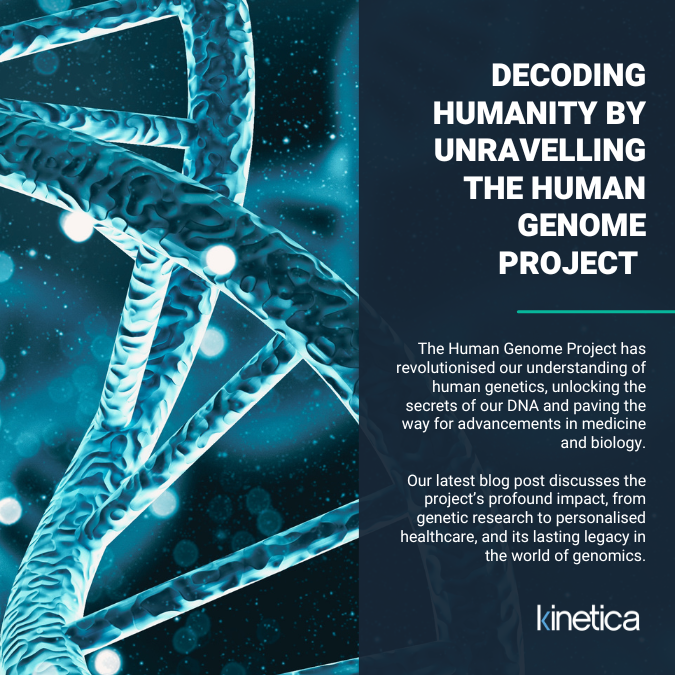INSIGHTS
The latest insights & news from Kinetica
Unravelling Cellular Complexity: A Dive into Spatial Omics
14 Feb, 20245In the ever-evolving landscape of biological research, the emergence of omics technologies h...

In the ever-evolving landscape of biological research, the emergence of omics technologies has revolutionized our ability to decode the intricacies of cellular function. The omics revolution, spanning genomics, transcriptomics, and proteomics, has provided unprecedented insights into the molecular underpinnings of life. However, until recently, these techniques were limited in their spatial resolution, hindering our understanding of how cells interact within their microenvironments. Enter spatial omics, a ground-breaking approach that bridges the gap between high-throughput analysis and spatial context, offering a holistic view of cellular organization and communication.
Spatial Omics Technology:
Spatial omics technologies can be categorized into two main approaches: Next-Generation Sequencing (NGS) and imaging-based methods. These encompass a diverse array of techniques, including:
- In situ sequencing (ISS): Techniques like FISSEQ and StarMAP enable sequencing directly within tissue sections, preserving spatial relationships.
- In situ hybridization (ISH): Methods such as MERFISH, seqFISH, and smFISH visualize RNA molecules within intact tissues, elucidating spatial gene expression patterns.
- NGS-based methods: Innovations like DBiT-Seq, HDST, and Pixel-seq leverage next-gen sequencing to map spatial transcriptomics at single-cell resolution.
- Multi-omics approaches: Technologies like Multiplexed RNA-protein ISH and MIBI enable simultaneous profiling of multiple molecular layers within tissues, providing comprehensive spatial maps.
The Market Landscape:
The spatial omics solutions market is experiencing rapid growth, with projections estimating a value of $671 million by 2031, driven by an 11.9% Compound Annual Growth Rate (CAGR). Market segmentation highlights diverse product types, application areas, analysed samples, and end-users, catering to a wide range of research and clinical needs.
Exploring Spatial Omics Companies:
• Stellaromics Inc.: Stellaromics utilizes STARmap technology for direct transcriptomic profiling from tissue, aiding in treatment target identification.
• Pixelgen: Pixelgen's Molecular Pixelation technology enables single-cell spatial proteomics, advancing applications from basic research to diagnostics.
• Cell Signaling Technology: Their SignalStar™ Multiplex IHC technology offers high-throughput, mid-plex IHC assays for flexible labeling of targets in FFPE tissues.
• AtlasXomics: AtlasXomics pioneers spatial epigenomic technologies with their DBiT-seq platform, providing multi-omic maps at cellular resolution.
• Centrillion Tech.: Centrillion Tech.'s DNA chip technology enables high-resolution spatial transcriptomics research, facilitating precise analysis of tissue samples.
• Rarecyte: Rarecyte's Orion™ Multiplex Imaging Instrument unlocks high-plex spatial biology, enabling comprehensive phenotypic profiling and characterization of tissue architecture.
• Neogenomics: MultiOmyx™ technology by Neogenomics allows visualization and characterization of up to 60 proteins in a single FFPE tissue section.
• Navinci Diagnostics: Naveni™ Proximity Ligation Technology by Navinci Diagnostics enables visualization and quantification of protein interactions and modifications with high specificity and sensitivity.
• Standard Biotools: The Hyperion™ Imaging System by Standard Biotools offers subcellular resolution imaging mass cytometry, providing insights into cellular relationships and phenotypes.
• STOmics: STOmics' Stereo-seq (SpaTial Enhanced REsolution Omics-sequencing) technology enables in situ sequencing of tissues, facilitating a deeper understanding of gene expression and cell morphology.
• Complete Genomics: Complete Genomics utilizes proprietary DNBSEQ technology for efficient and accurate NGS, including applications in spatial omics.
• Steam Instruments: Steam Instruments is developing technologies to improve mass-spectrometry resolution, advancing biomolecule mapping and quantification from tissue samples.
• Resolve Biosciences: Resolve Biosciences employs Molecular Cartography™ to provide the highest-resolution view of single-cell spatial biology while preserving tissue integrity.
• 10x Genomics: 10x Genomics offers solutions for single-cell, spatial, and in-situ technologies, including Visium Spatial Gene Expression for tissue classification based on mRNA.
• Nanostring Technologies: Nanostring Technologies provides digital molecular barcoding products for spatial biology research, including GeoMx® Digital Spatial Profiler for three-dimensional molecular interactions.
• Vizgen: Vizgen's MERFISH technology offers high-accuracy imaging of RNA molecules at subcellular resolution, enabling precise spatial transcriptomics.
• Akoya Biosciences: Akoya Biosciences offers spatial phenotyping solutions for visualizing and understanding cellular interactions in disease progression and therapy response.
• Ultivue: Ultivue provides multiplex biomarker assays for tissue phenotyping and digital pathology, enabling advanced exploration of tissue samples for precision medicine research.
• Canopy Biosciences: Canopy Biosciences' ChipCytometry™ technology offers quantitative multiplex immunofluorescence imaging for spatial analysis of complex tissues and cell populations.
• Flagship Biosciences: Flagship Biosciences employs AI-enabled cTA® pathology platform for spatial biology and biomarker services, delivering accurate and informative data.
• Ionpath: Ionpath's MIBI™ platform enables deeper understanding of tissue microenvironments through highly multiplexed, quantitative single-cell analysis.
• Miltenyi Biotec: MACSima™ Platform by Miltenyi Biotec enables exploration of spatial biology with advanced protein multiplexing capabilities and automated 3D imaging.
• Lunaphore: Lunaphore's chip technology transforms assays into multiplex spatial biology, offering intuitive solutions for spatial proteomic and transcriptomic data extraction.
• Rebus Biosystems: Rebus Biosystems' Rebus Esper platform delivers quantitative single-molecule, single-cell data with subcellular resolution for spatial omics research.
• Spatial Genomics, Inc.: GenePS device by Spatial Genomics enables imaging and decoding of complex molecular identities and locations within single cells and intact tissue microenvironments.
• Veranome Biosystems: Veranome Biosystems' Spatial Analyzer (Model VSA-1) provides stable and reliable spatial omics workflows, implementing high-plex spatial biology techniques.
• Curio Bioscience: Curio Bioscience offers a continuous high-resolution spatial whole-transcriptome solution, enabling unbiased gene expression mapping from fresh frozen tissues.
• Advanced Cell Diagnostics: Advanced Cell Diagnostics' RNAscope™ ISH technology allows detection and quantification of single RNA molecules, providing spatial gene expression results.
• Acuity Spatial Genomics: Acuity Spatial Genomics' OligoFISSEQ and OligoFISSEQ HD technologies empower researchers to visualize genome organization and 3D chromatin architecture of individual cells, directly in situ.
• Alpenglow Biosciences: provides a fully automated solution for spatial biology analysis, utilizing an open top light-sheet (OTLS) microscope and AI-enabled software for high-throughput 3D analysis of tissue samples and multi-well plates.
Exploring the Landscape:
The dynamic landscape of spatial omics is further enriched by a diverse array of companies driving innovation in this field. From Rarecyte's Multiplex Imaging Instrument to Resolve Biosciences' Molecular Cartography™, each technology offers unique insights into spatial biology, paving the way for ground-breaking discoveries.
As we delve deeper into the realm of spatial omics, we invite you to share your thoughts and insights. How do you envision the future of spatial omics shaping scientific research and discovery? Join the conversation and let's explore the transformative potential of spatial technologies together.
How do you foresee spatial omics technologies impacting your research or industry in the coming years?"
#spatialomics #genomics #proteomics #cellcharacterization #biotechnology #innovation



